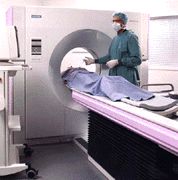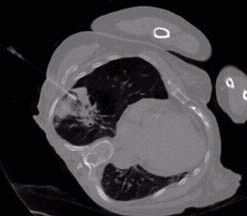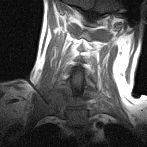 The radiologist performs a CT guided biopsy using "Fluoro CT" |
Many percutaneous biopsy procedures are performed with the help of some form of image guidance. Image guidance typically includes ultrasound and computed tomography (CT). Many breast biopsies are performed under guidance of stereotactic mammography.
Computed tomography (CT) scanning is being used more and more to guide biopsy of lung and liver lesions. Newer spiral or helical CT scanners are being equipped with so called "Interventional CT" or "Fluoro CT" packages to allow real time CT imaging for the guidance of biopsy. Interventional CT packages allow the radiologist to observe the biopsy needle in real time as it approaches and reaches the target lesion within the patient’s body. This significantly shortens procedure times and increases diagnostic accuracy.
 |
"Fluoro CT" guided biopsy of a lung abnormality, note the needle approaching from the upper left of the image. This is one image out of a series of images acquired dynamically at up to 8 frames per second. The radiologist can observe the trajectory of the needle as it is advanced towards the abnormality to be sampled. |
Ultrasound is also being used extensively to guide biopsy of the breasts and abdomen. Ultrasound allows great flexibility for following the path of the needle to the lesion to be sampled. Ultrasound also provides real-time display of the images as they are acquired. Ultrasound does not use x-rays and can provide additional flexibility to the radiologist or other physician since essentially unlimited imaging can be performed. The radiologist will determine if the abnormality can be seen well enough on the ultrasound to enable guidance. In some cases, ultrasound can show that a breast lump is a cyst (benign pocket of fluid), thus avoiding the need to perform a biopsy.
Stereotactic mammography is often used to guide breast biopsy using either the prone stereotactic mammography or upright stereotactic mammography technique. "Stereotactic" means that the breast biopsy path is imaged from two slightly angled directions to help guide the needle. Several stereotactic pairs of x-ray images are made. Small samples of tissue are then removed from the breast using a hollow needle that is precisely guided to the correct location via x-ray imaging and computer coordinates.
 MR guided biopsy of an abnormality in the lower neck, note black needle on left side of image. |
Magnetic Resonance (MR) Imaging is being used at various locations to guide biopsy. New open MR and "short bore" MR systems allow much greater access to the patient during scanning. This has enabled the development of techniques and tools to allow MR guided biopsy. MR can provide images in real-time which helps guide the trajectory of the needle as it approaches the target lesion. MR provides high contrast resolution which allows radiologists to differentiate between organ structures and abnormalities. Although use of MR guided biopsy is not yet widespread like CT or ultrasound guided biopsy, over time, MR imaging will be used by more and more hospitals and diagnostic centers to guide biopsy.
Updated: December 30, 2008



